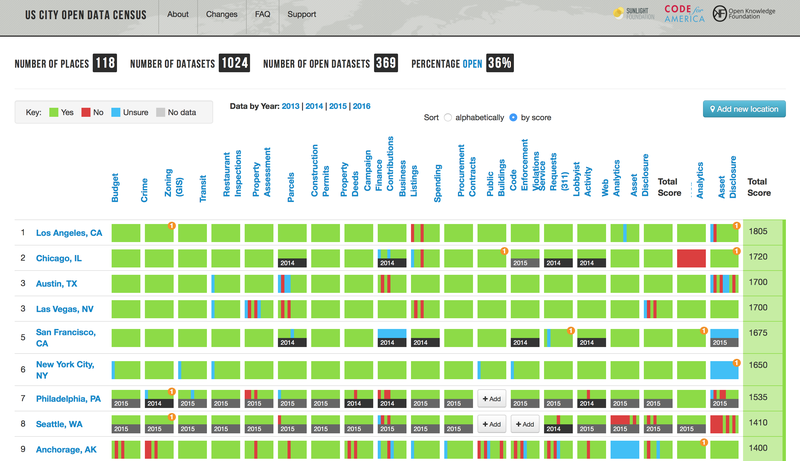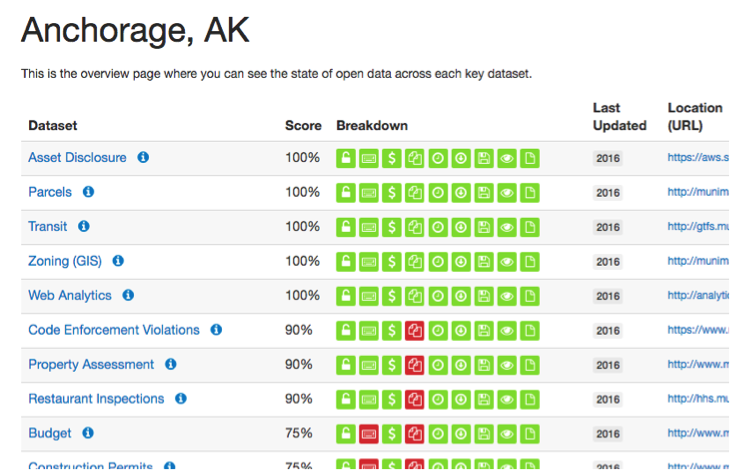The future of the US City Open Data Census

A few months ago, Sunlight launched our work on the US City Open Data Census with a blog post describing the census in transition. Sunlight had helped launch the census, then played an accompanying role in maintaining it. Earlier this summer, Sunlight upped our involvement, taking on the primary responsibility for a tool which, at its best, has been embraced by mayors and highlighted in the tech community — but which has lately fallen on harder times, with fewer submissions and out-of-date web pages.
Our goals for the census
Our subsequent work on the Open Data Census has revolved around three big goals:
- Updating the site: We wanted to clear any past backlogs and fully update the census site, with a straightforward process for running it in 2016 and beyond.
- Increasing visibility: We aimed to better connect the census with its original mission: raising awareness for open data and encouraging cities to learn from their peers in creating strong, effective open data programs that not only promote efficiency but accountability as well. As a result, we’ve sought to increase attention for the census from the public and the media, from city officials and even from promoters of open data like Sunlight itself.
- Integrating with other Sunlight work: We hoped to better integrate the census with the Sunlight Foundation’s other work — in analyzing and advising on open data policy and practice, in aiding our partners in the What Works Cities program, and in supporting transparency on issues ranging from lobbying to crime.
So where are we on these goals? Sunlight has steadily added new “open data librarians” — people who review submissions to the census — and added eight new cities. We targeted the technical side of the census site, fixing any links and HTML code that had broken since the site launched in 2014. We improved the “About” and “FAQ” pages, and crafted clearer language to prevent conflicts of interest with city employees. We soon realized that the census needed more comprehensive descriptions of each dataset to help guide users. We developed a thorough set of Dataset Explainers, giving tips on how to find datasets and what datasets ought to include, along with potential uses and suggestions for extra reading (for powerful visualizations, scary findings about 911 responses, or at least some neat SimCity music, feel free to check out the explainers below, or click here to view it in a new window!).
In order to better communicate progress on the census, we’ve been doing more writing about it on our blog, and, for the first time, now have a blog tag devoted to it. Sunlight is working to help city officials use the census to better engage their communities about open data, and we’re brainstorming activities where cities can use the census to spark public conversations about what datasets to release and how to release them.
We are further using the census to enhance our own understanding of open data. Currently, there are few ways to quantitatively measure open data access, particularly at the city-level. The census, though, has given us a rough tool to study where and how open data initiatives are operating. It has opened a window into bulk data access, correlations between population and open data access, and possible reasons why some small cities may have strong open data programs while others do not. We recognize that the census’ usefulness as a thorough, methodical research tool is limited, but we see huge potential for the census to give greater insights into open data implementation in the future.
Gathering feedback
To see how the census is being used and how it should be improved in the future, we surveyed our “librarians” and the general public. Some of the concerns we had heard before: These past few months, as in past years, city officials expressed frustration that they are evaluated for some datasets that are controlled by counties or states. Our philosophy has long held that the census should evaluate what datasets people in a city can access about their city, not necessarily what the city itself provides; otherwise, the census would not be able to include a large number of the cities or datasets that it currently features. As a result, we tried to make this point more clearly on the census website.
Other survey respondents commented that the census gives a hard ranking without taking into account local open data needs and capabilities. Several open data advocates in highly ranked cities reported that city officials used census scores as an excuse for inaction; meanwhile, people from lower-ranked cities felt discouraged that their communities seemed to fall behind well-resourced behemoths like New York and San Francisco. Our hope is to celebrate open data successes of all kinds while encouraging more improvement. Sunlight is quick to observe the shortcomings of even the largest open data programs, and happy to embrace the progress of smaller urban areas that lack other cities’ resources. No matter where a city appears on the census, there are plenty of ways to further boost open data — a fact that Sunlight will try to stress more to census cities in the future.

Future ideas
What changes might be in store for the census in the coming months? Some ideas:
- The census already covers a lot of datasets. What if we combined datasets like “Property Deeds” and “Property Assessments,” or “Zoning” and “Parcels”? Might this help to make the census simpler, and lower the bar for participation?
- We could add some important topics — like legislation or education — that are not currently represented in the census.
- Although we’ve already begun this work, we hope to further incorporate Sunlight content into the census site to make it easier for people interested in improving census results to find resources on creating an open data policy, strengthening existing policies or handling more sensitive information.
- We may work with Open Knowledge International in adjusting census weightings, and in giving a greater focus to metadata.
- Lastly, we plan to include more coverage of the census and what its results mean for open data on our blog and on social media.
When the census launched, our friends at Code for America called it “a foundational step for ensuring data can go ‘beyond transparency’ to be truly actionable.” Two years later, the census is no less important as a step toward ensuring truly open and accessible city data. It gives local advocates a chance to hold their cities accountable for open data implementation, and gives cities an opportunity to showcase their open data measures. Repeatedly, it has inspired conversations within communities and between activists and officials: As transparency fans from Ohio told us, “We use [the census] all the time when talking to stakeholders about the state of open data.” Sunlight hopes to see the mission of the census continue to grow, and we can’t wait to see how an active US City Open Data Census will be used by open data advocates in the years to come.

